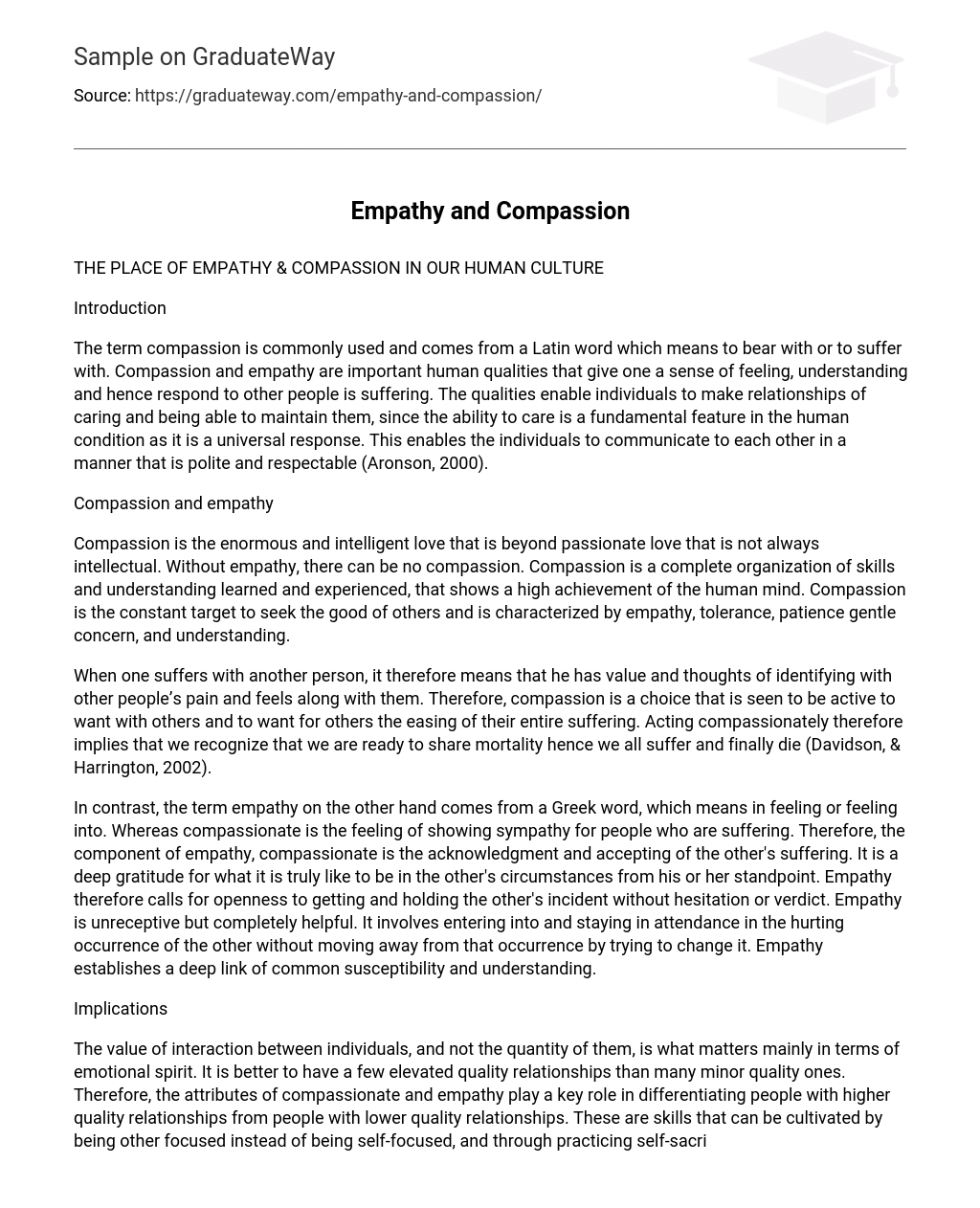The term compassion” is commonly used and comes from the Latin word which means “to bear with” or “to suffer with.” Compassion and empathy are important human qualities that give one a sense of understanding and enable them to respond to others’ suffering. These qualities allow individuals to form caring relationships and maintain them, as the ability to care is a fundamental feature of the human condition and a universal response. This enables individuals to communicate with each other in a polite and respectable manner (Aronson, 2000).
Compassion and Empathy
Compassion is an enormous and intelligent love that goes beyond passionate love, yet it’s not always intellectual. Without empathy, compassion cannot exist. It’s a complete organization of skills and understanding that are learned and experienced, showing the high achievement of the human mind. Compassion is a constant goal to seek the good of others and is characterized by empathy, tolerance, patience, gentle concern, and understanding.
When one suffers with another person, it means that they value and identify with the other person’s pain and share in their feelings. Compassion is a choice to actively empathize with others and desire to ease their suffering. Acting compassionately requires recognizing our shared mortality, as we all suffer and eventually die (Davidson & Harrington, 2002).
In contrast, the term empathy comes from a Greek word that means in feeling” or “feeling into.” Compassion, on the other hand, is the feeling of showing sympathy for people who are suffering. Therefore, as a component of empathy, compassion is the acknowledgment and acceptance of another’s suffering. It involves a deep gratitude for what it truly feels like to be in someone else’s circumstances from their standpoint. Empathy calls for openness to receiving and holding onto another’s experience without hesitation or judgment. It is unreactive but completely helpful, requiring one to enter and stay present in the hurting experience of others without trying to change it. Empathy establishes a deep connection of mutual vulnerability and understanding.
Implications:
The value of interactions between individuals, not the quantity, is what mainly matters in terms of emotional spirit. It’s better to have a few high-quality relationships than many low-quality ones. Therefore, compassionate and empathetic attributes play a key role in differentiating people with higher quality relationships from those with lower quality relationships. These are skills that can be cultivated by being other-focused instead of self-focused and through practicing self-sacrifice (Hoffman, 2000).
When in a relationship, it’s important to focus on key things: attention towards oneself or towards one’s partner. Compassion and empathy are essential attributes that shape an individual to focus on their partner’s experiences, especially during difficult situations. This can be challenging for most people in society. However, by developing these qualities, one can feel and understand their partner’s needs while making efforts to make them feel better and cared for.
In order to practice empathy and compassion, it is necessary to make an effort and set aside one’s own cares and worries for a while in order to maintain a growing relationship with one’s partner. Take the time to actively listen to what your partner has to say, paying attention not only to the words but also their demeanor and actions in order to fully understand their situation and depth of suffering. Analyze what they say and do, identifying any disconnections you may find, then take the opportunity for intimate conversation (Aronson, E. 2000).
The Buddhist Way
Compassion and empathy enable individuals to perform altruistic acts. It is often assumed that when one is being altruistic, they are losing something valuable without receiving anything in return. However, this is not always the case as there are multiple benefits to giving generously that may not be immediately apparent but will be realized later on. People recognize unselfish acts and appreciate their genuineness. For example, they become loyal to generous individuals and act generously towards them.
Being generous also exposes an individual to new generous associations that will benefit them in one way or another. The ability to act generously and altruistically has a positive impact on your self-esteem. Therefore, throughout your life, your flexibility and bond with other people become improved whenever you help those in need (Davidson & Harrington, 2002).
According to The Dalai Lama, achieving divine goals and ultimately freeing oneself from suffering and evil requires the intention to serve others. Selfish goals and methods alone are inadequate and inevitably lead to discontent. He teaches that each person can use their own intelligence to cultivate a higher consciousness characterized by compassion and ethical conduct. Roles are viewed as compatible; one person’s enemy may be another person’s friend. The sense of common altruism is elevated to a high moral code in the form of the golden rule. Both good and bad deeds are recognized as karmic agents that persist in a succession of causation without beginning or end (Hoffman, 2000).
Conclusion:
Therefore, every individual should make an effort to achieve compassion and empathy as they are important in day-to-day life. We all live with people with whom we need to interact, making these attributes necessary for maintaining good relationships. Compassion and empathy help human beings relate in a friendly manner and have respect for each other. Unselfish behaviors enable individuals to help each other without being self-centered or expecting any payment in return.
References:
- Aronson, E. (2000). Nobody Left to Hate: Teaching Compassion After Columbine. New York: W. H. Freeman and Company.
- Davidson, R. J., & Harrington, A. (2002). Visions of Compassion: Western Scientists and Tibetan Buddhists Examine Human Nature. New York: Oxford University Press.
- Hoffman, M. L. (2000). Empathy and Moral Development: Implications for Caring and Justice.New York: Cambridge University Press.





